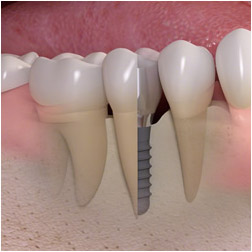Tucson Dental Implants
Southern Arizona Periodontics are your Dental Implant Specialists
Dr. Sharp and Southern Arizona Periodontics have performed tens of thousands of dental implant procedures right here in Tucson. You won’t find a more experienced team to give you the experience that is closest to natural teeth. Learn more about how dental implants work below, and please contact us if you have any questions or want to schedule a consultation.
What Are Dental Implants?
Teeth can be lost for a variety of reasons such as decay, trauma, or periodontal disease. Dental implants are a simple solution for replacing a lost or missing tooth, or even many teeth. Research has shown from well documented studies the long term results and benefits of dental implants. If provided by an experienced periodontist, dental implants can last a lifetime.
Losing teeth can really influence your life in a negative way. It can become harder to eat the foods you once enjoyed, your speech may start to be affected, you might even lose more teeth as a result of losing one or two. Dentures can be a hassle to take care of and a cause of discomfort. Fortunately, dental implants are able to replace your natural teeth in a comfortable, healthy, and permanent way. Dental implants mimic the root and crown of your natural teeth to such an impressive degree that you won’t even notice the difference!
Modern dental implants are easily the most impressive advancement in dental history. Being able to fully replace a tooth in both form and function is no small feat. The fact that it’s a permanent replacement that is capable of preventing bone loss in your jaw makes it even more impressive. As a result, the demand for dental implants has skyrocketed and the production methods have become more effective, resulting in a higher quality, lower cost product.
Same Day Implants
Another option that we offer for those that require an entire arch replaced, such as patients currently using dentures or are eligible for dentures, is the All-on-4 Dental Implant procedure.

Schedule a Dental Implant Consultation Today
Call our office to talk to one of our friendly staff to answer any questions you might have or schedule an appointment right away.
Dr. Sharp has been providing dental implants in Southern Arizona for over 30 years, having performed over 10,000 implant procedures! This is the experienced team that will ensure the best quality and care by getting back the closest thing to real teeth!
Dental Implant Procedures
Implants are carefully placed into your jaw bone through a surgical procedure. This procedure can be performed in our office with the use of local anesthesia and oral, general, or IV sedation. In the vast majority of cases patients who have undergone the dental implant procedure can return to work the day after the procedure. Cases where patients ten to miss more work are ones in which the patient has multiple implants place in one day.
Once placed the implants will require several months to heal, during which time the bone in your jaw will grow around them in a process known as osseointegration. Once the bone has grown to a point that it can properly support the implants in the act of chewing it will be time to place the rest of the prosthesis on them. It can take anywhere from four to nine months to place the final prosthesis on the implant posts but there are situations where we will place them the same day. There are usually at few visits to our office in between placement of the post and the prosthesis in order to ensure that everything is healing properly.
Do Implants Work?
Dental implants are proven to be the most effective tooth replacement option available today. Implants are so good at replacing natural teeth that they even are able to stimulate the jaw bone in order to prevent bone loss in the areas they are placed – the same way natural teeth stimulate the bone; this is something that no other tooth replacement option offers.
Implants are one of the most reliable and predictable long-term tooth replacement methods in history. We are able to place implants with a very high degree of certainty of their success. Because implants are fabricated, they offer some advantages over natural teeth. Implants cannot decay, and are typically much stronger and more durable than a natural tooth. This does not mean that you can skip brushing and flossing, it just means that your implants are very reliable.
Immediate Restoration Implants
Sometimes we are able to place implants and provide temporary prosthetic teeth at the same time. This is not a simple or necessarily common occurrence but it does happen occasionally. Make sure to inquire with us if this is something that interests you and we will see if you are a good candidate for this procedure.
Am I A Candidate for Dental Implants?
The Implant Evaluation
If dental implants are something that you think could help improve the quality of your life, please give us a call at 520-200-2272 and schedule a no obligation consultation so that we can determine whether dental implant are right for you. Implant evaluations are important for us and for the patients. When we have a chance to sit down with you, evaluate your mouth, and describe to you what challenges we face in your treatment, you will be able to make a well-informed decision about your oral health.
Your implant evaluation will take roughly an hour to complete. During the evaluation we will take a 3D scan of your mouth using a cone beam CT scanner. This will allow us to create a 3D image of your mouth that we will use to create a detailed treatment plan for you. During the evaluation we will discuss:
- Treatment Recommendations
- Options for prosthetics
- Approximate number of visits required
- Fees
- Time requirements
What Happens If I Don’t Have Enough Bone?
Implant Site Preparation
During the evaluation, we will determine whether or not you have enough bone mass in your jaw to support dental implants. If you do not there are plenty of ways that we can bolster your bone mass before beginning the implant procedure in order to give you enough bone to support your implants. In the event that we need to add bone mass to your mouth we refer to the process of doing so as implant site preparation. Here are some of the different kinds of implant site preparation procedures.
Extraction Site Preparation
One of the more common forms of implant site prep, extraction site preparation happens while we are extracting teeth that are (typically) in the way of the prosthesis that we will eventually place. Site recovery can require up to six months to heal and allow for the bone to harden adequately.
Ridge Augmentation
The ridge of your jaw is where the teeth sit. In the event that a patient has gone without teeth for some time, the ridge can suffer bone loss. Using ridge augmentation we build the ridge to prepare the jaw bone to receive an implant.
Sinus Augmentation
The maxillary sinuses are located above your upper molars. The sinus cavities are the passages through which air travels from your nostrils to the back of your throat. They are short, winding passages that are lined with a thin membrane. It is important for us to take the sinus cavity into consideration when placing implants in the posterior roof of your mouth.
It sometimes becomes necessary to lift the sinus cavity out of the way of the implant, in order to avoid damaging any part of your sinus cavity and to ensure that the implant will have adequate support.
Vertical Sinus Augmentation
When there is some bone remaining between the sinus and the planned implant site we can sometimes push it up toward the sinus and fill the void left behind using a vertical sinus augmentation. After the bone has been altered we can place a graft in the site where the bone was moved from. Implants are typically placed between 4 and 6 months after this procedure is finished.
Lateral Sinus Augmentation
When there is very little bone left between the procedure sit and the sinus cavity/lining lateral sinus augmentation allows for the most amount of bone regeneration possible. We create a window to the side of the jawbone and expose the sinus membrane with it. The membrane is carefully lifted using this window in order to provide room for the bone grafting material that we will then place below it. Implant placement can sometimes follow immediately but often require 4-6 months to be placed following this procedure.
What Is Involved in Getting Dental Implants?
There are four phases to implant treatment. They are:
- Implant placement
- Implant uncovering
- Prosthetic phase (providing replacement teeth)
- Maintenance phase
Phase I – Implant Placement
During this phase, we will place the titanium posts into your jaw. We do this in our office using a local anesthetic (Novocain) and oral or IV sedation, depending on what you prefer. We do offer a board-certified anesthesiologist for those who wish to undergo IV or general sedation – just let us know what you would like ahead of time.
This is the most intensive portion of the procedure and will (typically) require a decent amount of recovery and healing time. Implants often sit submerged below the gum line and are difficult or impossible to see. Sometimes they are left exposed and look a bit like a round piece of metal that is flush with the gum line. During recovery, the bone around your implant is hardening and growing around the implant threads in a process called osseointegration.
During recovery from this procedure you can wear temporary prosthesis and may need to resort to a softer foods diet. You can usually return to work the day following the procedure. We prescribe medication to ensure your comfort as well as antibiotics.
Phase 2 – Implant Exposure (not always necessary)
If the implants are submerged in your gums while your recovery this will be a necessary following procedure. Once we are confident that the bone has integrated with the implant we can follow up with this minor procedure. We will uncover the implants and attach a healing collar to the top of them. The collar helps to keep them exposed while giving your gums a clear boundary of where the prosthetic will sit in order to prep the area.
After the collar has been attached you will still be able to wear any temporary prosthesis you need. If the implant was never below the gums, this is a step that doesn’t need to take place.
Phase 3 – Implant Prosthetics (providing replacement teeth)
After several week the soft tissues of your mouth will be healed enough for us to take some impressions of your mouth. We will use these impressions to fabricate the prosthesis that will be held in place by your implant. Implants can serve as the foundation for single teeth, dental bridges, even full dentures be supported in a permanent way by implants. It will take several weeks for the prosthesis to be fabricated.
Once healing is done and the prosthesis has been fabricated it will be time to attach the prosthesis. We place an abutment on top of the implant, which gives the prosthesis the surface area that it need to be attached firmly to the implant. We use a permanent dental cement when placing permanent prostheses.
Phase 4 – Maintenance
When you have your finished implants and restorations placed, that’s just the beginning of your life with your implant. Just like anything that you want to stay nice, you have to treat is nicely. Dental implants can last you many decades, even your whole life if they are cared for properly. Make sure to take care of your teeth at home and come in regularly for professional examinations and cleanings.

